

RSS Web Syndication Basics. RSS - What is Really Simple Syndication? - RSS Explained. RSS stands for Really Simple Syndication and represents the standardized web feed syndication.
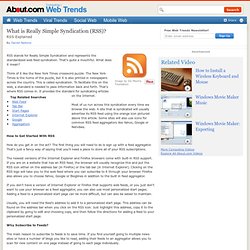
That's quite a mouthful. What does it mean? Think of it like the New York Times crossword puzzle. The New York Times is the home of the puzzle, but it is also printed in newspapers across the country. This is called syndication. Most of us run across this syndication every time we browse the web. How to Get Started With RSS How do you get in on the act? The newest versions of the Internet Explorer and Firefox browsers come with built-in RSS support.
If you don't have a version of Internet Explorer or Firefox that supports web feeds, or you just don't want to use your browser as a feed aggregator, you can also use most personalized start pages. Usually, you will need the feed's address to add it to a personalized start page. RSS Syndication. Shared RSS - RSS Syndication RSS Syndication RSS Syndication or RSS Newsfeeds (RSS Feeds for short) all refer to the same thing.
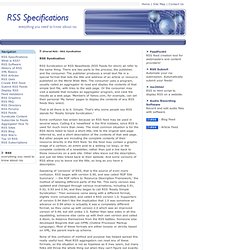
There are two parts to the process, the publisher, and the consumer. The publisher produces a small text file in a special format that lists the title and address of an article or resource published on the World Wide Web. The consumer uses a program, usually called an aggregator to read and display the contents of that simple text file, with links to the web page. What is RSS: A tutorial introduction to feeds and aggregators. What is RSS?
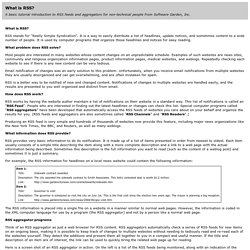
RSS stands for "Really Simple Syndication". It is a way to easily distribute a list of headlines, update notices, and sometimes content to a wide number of people. It is used by computer programs that organize those headlines and notices for easy reading. What problem does RSS solve? Most people are interested in many websites whose content changes on an unpredictable schedule. Email notification of changes was an early solution to this problem. RSS 2.0 Specification (version 2.0.11) RSS 2.0 Specification Archivist's Note: This is version 2.0.11 of the RSS 2.0 specification, published by the RSS Advisory Board on March 30, 2009.
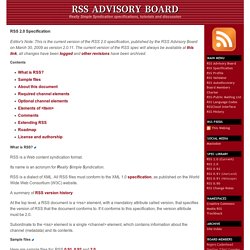
The current version of the RSS spec will always be available at this link, all changes have been logged and other revisions have been archived. Contents. What Is RSS. December 18, 2002 RSS is a format for syndicating news and the content of news-like sites, including major news sites like Wired, news-oriented community sites like Slashdot, and personal weblogs.
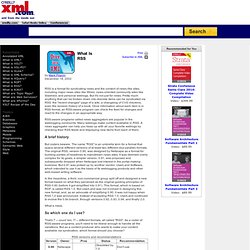
But it's not just for news. Pretty much anything that can be broken down into discrete items can be syndicated via RSS: the "recent changes" page of a wiki, a changelog of CVS checkins, even the revision history of a book. Web syndication - eNotes.com Reference. Automatic and free RSS feeds for everyone. RSS: Lightweight Web Syndication. July 17, 2000.
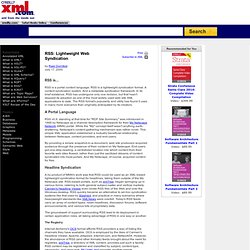
RSS - A Primer for Publishers and Content Providers. These guidelines have been produced by EEVL, the Internet guide for engineering, mathematics and computing, as part of a JISC funded PALS Metadata & Interoperability project which aims to encourage the sharing of news and alerts in machine readable formats.

Thanks go to our project partners (Centaur Communications, Pro-Talk Ltd and Gojobsite) for their input and to Andy Powell and Paul Miller of UKOLN for their valuable comments and feedback. This document is aimed at publishers and content providers with the intention of introducing & explaining the concepts behind RSS and addressing some commonly expressed concerns. It is primarily intended for a non-technical audience who require an overview of RSS in order to allow them to make decisions regarding the possible use of the technology. Introduction to RSS - WebReference.com. Introduction to RSS Want more traffic?
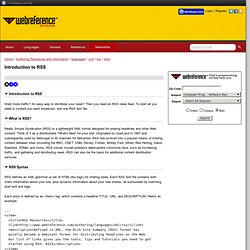
An easy way to distribute your news? RSS. RSS (Rich Site Summary); originally RDF Site Summary; often dubbed Really Simple Syndication, uses a family of standard web feed formats[2] to publish frequently updated information: blog entries, news headlines, audio, video. An RSS document (called "feed", "web feed",[3] or "channel") includes full or summarized text, and metadata, like publishing date and author's name. RSS feeds enable publishers to syndicate data automatically. A standard XML file format ensures compatibility with many different machines/programs.
RSS and You. RSS is Born Netscape had one of the first "portals" on the Web, a place where users could go to get most of their information needs fulfilled: search engines, news, email, and more.
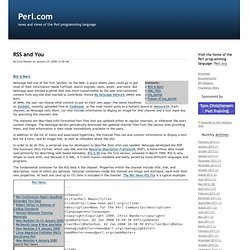
But Netscape soon wanted a portal that was more customizable by the user and contained content from any site that wanted to contribute. Hence My Netscape Network (MNN) was born. At MNN, the user can choose what content to put on their own page—the latest headlines on Slashdot, recently uploaded files at freshmeat, or the most recent posts to a bulletin board at Network54. Each channel, as Netscape calls them, can also include information to display an image for that channel and a text input box for searching the channel's site. The channels are described with formatted text files that are updated either at regular intervals, or whenever the site's content changes.
In order to do all this, a universal way for developers to describe their sites was needed. Using RSS News Feeds - Webreference.com. Using RSS News Feeds Abstract The Rich Site Summary (RSS) format, previously known as the RDF Site Summary, has quietly become the dominant format for distributing news headlines on the Web.
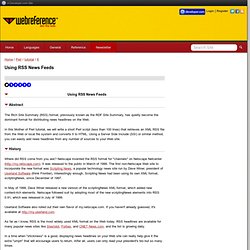
In this Mother of Perl tutorial, we will write a short Perl script (less than 100 lines) that retrieves an XML RSS file from the Web or local file system and converts it to HTML. Using a Server Side Include (SSI) or similar method, you can easily add news headlines from any number of sources to your Web site. History Where did RSS come from you ask?
In May of 1999, Dave Winer released a new version of the scriptingNews XML format, which added new content-rich elements. RSS » ¿Qué es RSS? RSS in Plain English - 54 Translation. RSS 2.0 Specification (RSS 2.0 at Harvard Law) Internet technology hosted by Berkman Center Tuesday, July 15, 2003 Contents.